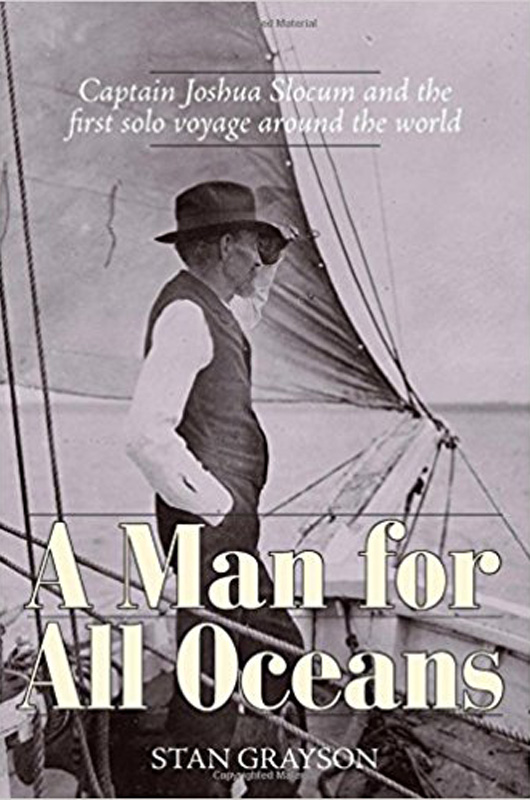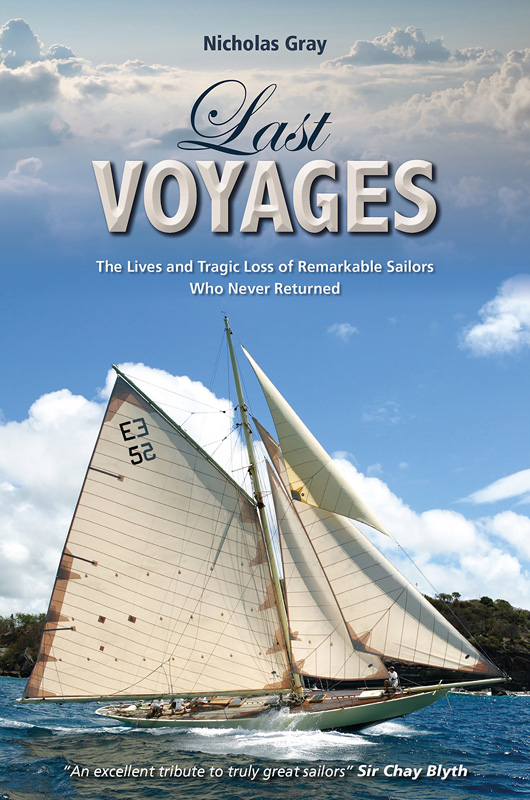As winter finally sets in, and the boat is buttoned up and other winter preparations made, it is time to turn inward, to a comfortable chair to catch up on some maritime reading, the next best thing to being on the water.
This year was a good one for maritime books, several with Vineyard ties. The reviews begin with A Man for All Oceans by Stan Grayson, published in 2017 by Tilbury House Publishers with the New Bedford Whaling Museum. The book is the definitive biography of one of America’s most famous sailors, Capt. Joshua Slocum.
Born in Nova Scotia in 1844, and eventually a naturalized American, Captain Slocum was truly a master mariner, sailing all the oceans of the world on a variety of sailing vessels. During a voyage to Australia in 1871 he met and married Virginia Walker, who sailed everywhere with him for 13 years, while bearing seven children (four survived), all at sea. When Virginia died in 1884 in Argentina, Joshua was bereft, but he eventually remarried a cousin named Henrietta several years later.
The Slocums bought a farm in West Tisbury (Hettie was at best a reluctant sailor) but Joshua found that life on land was irksome, and after rebuilding a 37-foot aging sailboat that he had been given in Fairhaven, he decided to sail around the world. He named the boat Spray and departed on his voyage from Boston in late April of 1895, returning after 45,000 nautical miles, the first single-handed circumnavigation of the world, in June of 1898.
Writing about his adventures, Captain Slocum authored one of the greatest maritime books ever: Sailing Alone Around the World. The book of that journey found instant success and has been republished many times. Considering that Captain Slocum never achieved more than a third grade education, his skills as a skipper, and a writer, are all the more remarkable.

It could be considered morbid to follow with a book about unhappy endings, but I will anyway. In Last Voyages by Nicholas Gray, published by Fernhurst Books, none of the voyages end well. Consider a lengthy chapter about a sailor named Mike McMullen, who sailed a trimaran designed by Richard Newick, named Three Cheers. (On a side note, some Island sailors well remember Dick Newick, who lived here for many years. He was an incredibly talented designer of simple and elegant as well as fast and seaworthy multihulls.)
Mike McMullin was a great skipper and sailor (author of Multihull Seamanship) who hailed from the Isle of Wight. He was entered to sail the 40-foot Three Cheers in the 1976 Ostar. Just before the race, McMullin’s wife Lizzie was electrocuted while working on the boat, and the race actually started the day after her funeral. Mike’s spirits can only be imagined as he sailed over the starting line. He disappeared during the voyage, with parts of the boat eventually washing up in Iceland. I’ll let you ponder the lessons of that voyage, before moving on to other voyages with tragic endings.
Other last voyages recounted here include Frank Davison, Donald Crowhurst, W.H. Tilman, Alain Colas, Richard Pendred, Angus Primrose, Rob James, Peter and Thomas Tangveld, Eric Tabarly and Philip Walwyn, who sailed a 12-meter that he built from an old gaff rig design on St. Kitts. In 2015 he sailed Kate single-handed (he was 68) from Nova Scotia to England via the Azores. Along the way and in several storms he lost the self steering. After repairing it in the Azores, it broke again and he was unable to use it. Arriving off the Lizard in Cornwall he apparently fell overboard as Kate was found with the sails up and sailing in circles, while he was found floating face down several hours later. Though alive, he died in hospital.

Moving on from last Voyages, perhaps to happier journeys, Though Shalt Knot by Dr. Christina Connett was published several months ago by the New Bedford Whaling Museum. This is the catalogue for an extensive exhibit of Clifford Ashley’s work currently on display at the museum. Those who have visited the exhibit have praised the rope work, displays of knots, paintings and other work by Ashley. A native son of New Bedford, he played many parts in the maritime life of New Bedford over his long life. One part was his involvement in the 1930s to try and raise the funds necessary to keep the whaling vessel Charles W. Morgan on display in New Bedford. Another facet of Ashley’s life was his work as an artist and anyone fortunate enough to have a painting or print of his is lucky indeed. However, Ashley is perhaps best known for his fabulous book: The Ashley Book of Knots still in print after initial publication in 1944. The book depicts thousands of knots all carefully categorized and illustrated by the artist. His family gave his collection of knots to the museum back in 2016 and this book accompanies the exhibit of those knots and other work, which will be on display until next June.
If anyone is interested in more of Ashley’s work, please go to the Mattapoisett Historical Society (summer months only) where you can find A Chart of the Whale Coast of New England circa 1810 (also portrayed in a book) done by Ashley, which is a graphic look at this coast. The chart measures 6 feet by 16 feet and is a fascinating depiction of the coast and the whales. This is pertinent as we watch the precipitous decline of the Atlantic right whale, with the loss this year of 17 (possibly 18) out of a population of fewer than 500.
Clifford Ashley also wrote and illustrated The Yankee Whaler, which is still considered to be one of the best of its genre. To digress a bit further, Henry Beetle Hough wrote, back in the day, a wonderful book for kids titled Great Days of Whaling. Published in 1958 by North Star Books of Houghton Mifflin as part of a lengthy series of titles about American history for kids, it is hard to find but well worth the effort.

A houghtful and modestly priced addition to any sailor’s reading would be a subscription to Mike O’ Brien’s always interesting magazine of boat plans. Titled the Boat Design Quarterly, it is thoughtfully designed and printed on durable paper and sells for a modest $24 for four copies. It is also available digitally in PDF format.

So Far So Good by Paddy Barry is a paperback book published by the Liffey Press in 2017. An autobiography of sorts, this is a wonderful story of his adventures both on land and sea, with the sea stories predominating. One of the adventures he writes about is sailing his Hooker Saint Patrick from Teneriffe to Martha’s Vineyard in the spring of 1986 to take part in special tall ships events in New York and Boston. He also includes stories of his voyages from Alaska to Siberia and from Greenland to Antarctica, where in 1997 he replicated Shackleton’s journey from Elephant Island to South Georgia in a boat he named Tom Crean.

Olly Perkins is a talented young British sailor — just 15 this year. As a project and with the help of British journalist Tom Cunliffe and others, Olly has studied weather and meteorology. In particular he has studied clouds, and several months ago he self-published a 70-page book titled The Message of the Cloud, How You Can Forecast the Weather. Filled with facts, illustrations, photos, definitions, explanations, weather lore, a glossary, index, and many tips as well as a final “quiz,” Olly has written a book that would be the envy of many a professional meteorologist.

The New History of Yachting by Mike Bender deserves a mention for many reasons but most important because it is a very up-to-date history of British yachting. Despite the cover painting of the schooner American by American painter Fitz Hugh Lane, this is 99 per cent British yachting history. Something that caught my eye is how few yacht clubs or associations encouraged female members and many did not even allow them on the premises (“no women and no dogs”) although presumably these sorts of rules and restrictions applied to those of other races, religions and ethnicities, as well as to the LGBT community. One wonders how much covert, if not overt, discrimination still lingers.
Happy reading. May it keep you until the warm weather and life on the water returns.







Comments
Comment policy »